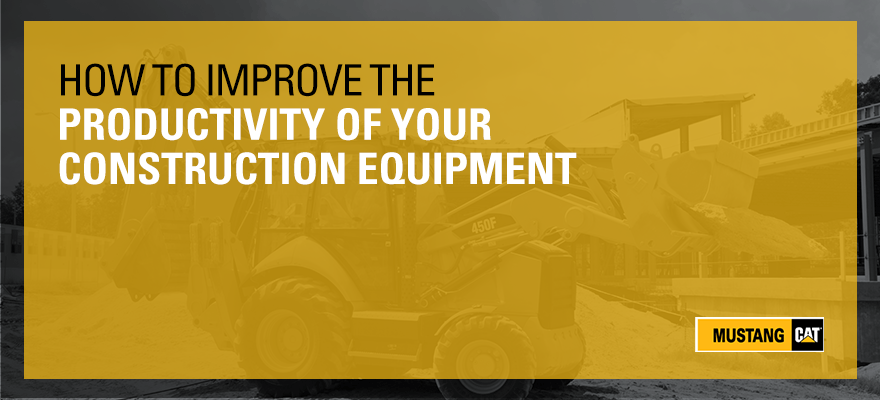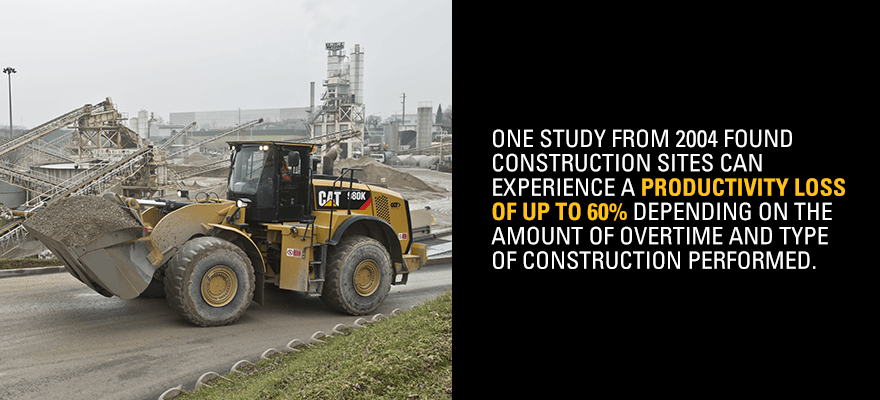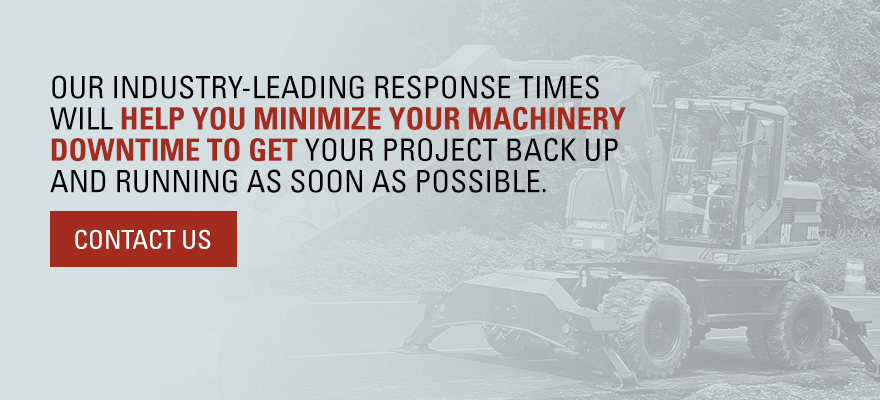How to Improve the Productivity of Your Construction Equipment

Productivity is a deciding factor in any business’ success, and this is no different within the construction industry. When multiple variables determine how efficient your team is, it’s essential to know where your business stands on each one. Equipment productivity in construction is one element that can make or break an operational structure. Without well-functioning machinery, it’s nearly impossible to construct the desired end product.
Following construction equipment productivity norms can improve your efficiency and ensure you meet your client’s needs each time. If you need some guidance on how to get the most out of your fleet, our guide to increasing machinery productivity can help.
Why Equipment Productivity in Construction Matters
Construction professionals often think of their efficiency rates in terms of manual labor. How many people are working on a project? Do they all have adequate training? Does everyone have fair, manageable tasks for the given timeframe? These factors matter significantly, but so does equipment performance. A machine that’s fallen behind in its maintenance schedule may not work as well as one that receives regular upkeep.
Similarly, an engine that’s too small or large for the given job won’t serve the assignment as effectively as one that’s properly suited for it. The productivity of construction equipment has been a major topic in the construction industry for years. Specifically, the industrial building sector has seen the most improvement, with an average annual 2.3% increase in productivity. Meanwhile, single and multiple-family residential construction — along with highway and bridge construction — have fallen behind.
High-quality building projects rely on cohesive teams, strong leadership and durable equipment. If one of these areas is lacking, the entire job site feels the effects. To keep creating work that clients will be satisfied with, it’s crucial to closely manage each of these aspects and make improvements where necessary.
Common Causes of Idle Time
There are many reasons why construction sites often see diminished productivity rates. Here are just a few of them:
- Lack of Training
A lack of employee training leads to a disorganized worksite. This factor can encompass several different aspects of the job — like a lack of training in safety protocols, equipment management or communication best practices. No matter which one you’re dealing with, it will affect the rest of the project unless you address the issue proactively. Even your most skilled workers require periodic re-training, especially if they’re working with new equipment.
2. Unserviced Engines
A proper maintenance and repair schedule — most often, the one recommended by the manufacturer — is necessary for maintaining a smooth-running machine. Stopping your operations for scheduled maintenance will inevitably result in some downtime, but it’s better to respond with preventative upkeep than reactive repairs.
By the time a piece of heavy equipment has reached the point where it needs major repairs, the costs and time required to fix it will have increased exponentially — this issue causes unplanned downtime, which is harder to compensate for than downtime you were already anticipating.
3. Extended Overtime
Scheduling overtime means doing more work, which should technically foster more productivity — but it’s not always that simple. Tacking on additional shifts can bring down your construction site’s efficiency rates after a certain point. One study from 2004 found construction sites can experience a productivity loss of up to 60% depending on the amount of overtime and type of construction performed.

Employees start feeling fatigued and become more vulnerable to distractions, which can lead to serious accidents or injuries. Additionally, they may lose morale from consistently working longer hours and losing their work-life balance, which facilitates a higher turnover rate.
4. Ineffective Management Techniques
It’s not uncommon for unproductive worksites to stem from inefficient managerial departments, even when the company employs the best heavy equipment and offers high-quality training materials. Ultimately, the workforce needs capable and organized leaders to succeed. Old and unserviced machines can cause project slowdowns and halts, but buying new equipment won’t entirely solve this problem if management doesn’t also do their part to improve workflow.
How to Boost Construction Equipment Productivity
How can you improve construction equipment productivity rates with every project you take on? Here are a few methods you can try to kickstart efficiency and effectiveness within your business:
- Develop a Maintenance Schedule
Many new machines have a range of specialized features that help them do their job, such as computerized elements. These are convenient and much-needed on the job site, but they can make maintenance more complex than it would normally be, which can slow down the productivity rates of your construction equipment. Plus, it may prove challenging to do this kind of maintenance in-house if your employees don’t know all the intricacies of such advanced machines. In that case, you can save time by hiring a dealer technician.
Your dealer can assist with numerous tasks involved in maintaining your equipment — including data collection for machine technology. Don’t hesitate to reach out to them for repairs or other needs. Additionally, make oil and fluid analysis a regular part of your plan. High-quality, uncontaminated fuel is vital for a reliable machine.
2. Train Your Employees
Although you may employ a dealer technician for overall maintenance, it’s still necessary to train your employees in how the equipment works. This knowledge will save them from making mistakes that cost time and money or even result in worker injury. If your workers aren’t well-versed in the machinery you use on-site, they could squander valuable time trying to piece together how it works — or they could unintentionally cause damage.
Establishing a job site safety plan is one of the most straightforward ways to boost productivity. Workers who understand how to maintain project safety and avoid cutting corners with work will consistently uphold the standards you create.
3. Employ Fleet Management Software
Construction equipment productivity software can do wonders for enhancing your fleet’s workflow and keeping everyone accountable. You can track variables for specific machines — such as excavator productivity per hour — plus more broad categories like site measurements, grade checks, and more. SCITECH offers solutions such as 2D and 3D Machine Control and VisionLink software to make managing your worksite easier.
Whether you want to check on the movement of materials or add another machine to your fleet, software options can enable these abilities at the click of a button. Many software solutions are also cloud-compatible, meaning you can take your data wherever you go.
4. Choose Equipment Wisely
Ideally, you only want to buy heavy equipment that’ll have a high utilization rate. Every other machine can serve its purpose well as a rental. You’ll save more money by renting the tools you know you won’t use very often versus investing in them with a purchase.
The type of machinery you choose will determine your construction equipment productivity rates, though the machine alone doesn’t guarantee enhanced efficiency. Your business must know how to utilize the equipment to get the most value from it. It works for you, but you must also work for it to some degree — with maintenance and repairs — to keep it functioning effectively.
Used equipment has many advantages in this arena. It offers a lower upfront cost while maintaining the same or a very similar level of performance as a new machine. Renting or buying pre-owned machines and performing regular maintenance checks on them can save you a lot of money over purchasing new equipment outright. Used autonomous machines can offer even higher monetary gains by doing more work with less labor.
Contact Mustang Cat for Reliable Construction Equipment
Mustang Cat is a family-owned Cat® dealer, offering best-in-class warranties and access to high-quality parts and services. If you’re in the market for a new addition to your fleet, we can help. Our team of skilled professionals will guide you through the process, ensuring you receive expert the guidance you need when making such a major investment.
With over 60 years of experience in heavy machinery, power systems and more, we know how to serve our clients best — and our Mustang Promise helps us do just that. Our industry-leading response times will help you minimize your machinery downtime to get your project back up and running as soon as possible. Contact us today for advice on selecting your next piece of heavy equipment.



